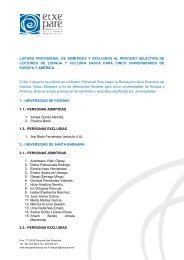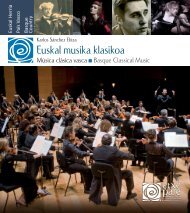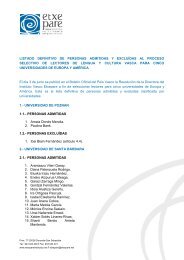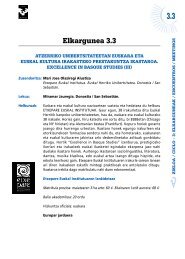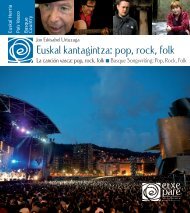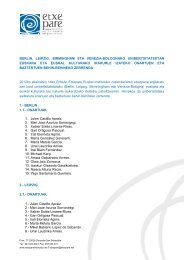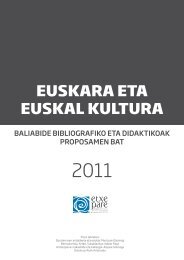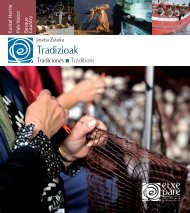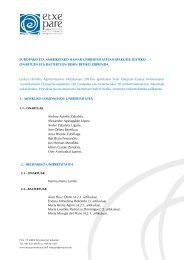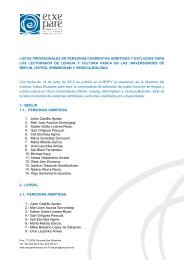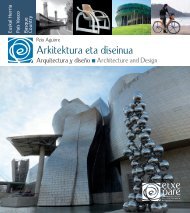Euskal dantza - Etxepare, Euskal Institutua
Euskal dantza - Etxepare, Euskal Institutua
Euskal dantza - Etxepare, Euskal Institutua
You also want an ePaper? Increase the reach of your titles
YUMPU automatically turns print PDFs into web optimized ePapers that Google loves.
Además de las oportunidades para ver actuaciones dedanza tradicional, están cada vez más extendidas lassesiones de baile en las que se ofrece la posibilidad deparcipar. Al son de la música de un grupo en directo,un maestro de danza guía el baile dando instruccionessobre cada danza y poniendo a bailar a los parcipantesque no tenían ningún conocimiento previo.En la década de los 90 la Escuela de Folclore del Ayuntamientode Vitoria organizó un calendario de bailesdinamizados por los profesores del centro. Junto aestos, los bailes populares que se organizan en lasfiestas de las capitales pueden ser los antecedentesde las romerías guiadas del País Vasco. En el mismoperiodo, empezaron a extenderse por la costa de Laburdicursos para aprender <strong>dantza</strong>-jauziak y los bailesabiertos o mutxikoak para bailarlos en público los finesde semana. Simultáneamente, en el café-teatroKafe Antzokia de Bilbao se puso en marcha una sesiónmensual que se denomina Urbeltzen Dantza Ganbarapor ser Juan Antonio Urbeltz quien lo dirige.Los bailables guiados se extendieron por todo el paísfundamentalmente de la mano del profesor labortanoPatxi Pérez. Con un repertorio que conjuga danzasdel lugar con otras extendidas por Europa, Perez aplicóen el País Vasco el modelo del fesval Le GrandBal de l’Europe que se celebra en el pueblo francésGennenes. Acompañado por los grupos Batbiru, Tapiaeta Leturia o Patxi eta Konpania, Patxi Pérez hapuesto en danza centenares de plazas en los úlmosdiez años.El movimiento de los aficionados a la danza ha seguidocreciendo durante la primera década del sigloXXI. El grupo Aiko ha hecho aportaciones para renovarel modelo de enseñanza de la danza, mientras lasoportunidades de bailar danzas tradicionales en sesionesabiertas se han mulplicado. Gracias a gruposcomo Lauetan Erdizka, Kokin o Arrabots, las romeríasguiadas han llegado a la mayoría de rincones de lageograa vasca.As well as the opon of watching tradional danceperformances, there are more and more danceswhich offer people the opportunity to dance directlyin a group. If people who take part in dance groups aredancers, people who take part in these guided dancesare dance aficionados. To the tunes of a live musicalband, a dance master guides or leads the dance by givingpeople informaon about each of the dances theywill undertake; and helping those parcipants who donot know the dance to get dancing.In the 1990s, the municipal folklore school in Vitoria-Gasteiz organised a dance calendar and arranged forstudents at the school to help out by livening up thedances. These events, together with the open dancesorganised during big city fesvals could be consideredthe forerunners of these guided dances in the BasqueCountry. At the same me, courses were introducedon the coast of Lapurdi for people to study the <strong>dantza</strong>jauziakand the mutxikoak (young boy’s dances), andat weekends mutxiko dances were held more andmore frequently. Meanwhile, the Urbeltzen DantzaGanbara (Urbeltz’s dance chamber) began funconingat the Kafe Antzokia (Theatre Café) in Bilbo.This explosion in guided dances began with a danceteacher from Lapurdi, Patxi Perez. He started by applyingthe model used at the Le Grand Bal de l’Europe(Great European Ball) fesval in Gennenes, France,to Basque dances and many other dances from allover Europe. In the last ten years, together with theBatbiru group, Tapia eta Leturia (Tapia and Leturia, atrikixa or diatonic accordion player and panderoaor tambourine player), and Patxi eta Konpainia, PatxiPerez has brought hundreds of town squares to lifewith parcipatory dances.In the twenty-first century groups like Aiko havemodernised dance teaching methods and encouragedmore systemac meengs of aficionados. Similarcontribuons to guided dances have been madeby groups like Lauetan Erdizka, Kokin and Arrabots.53



